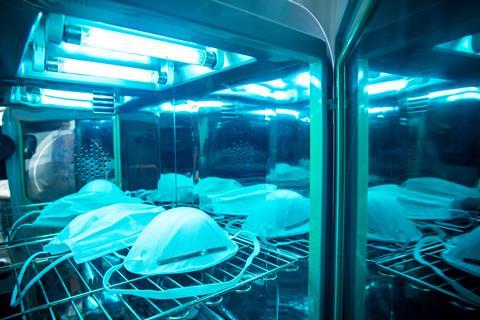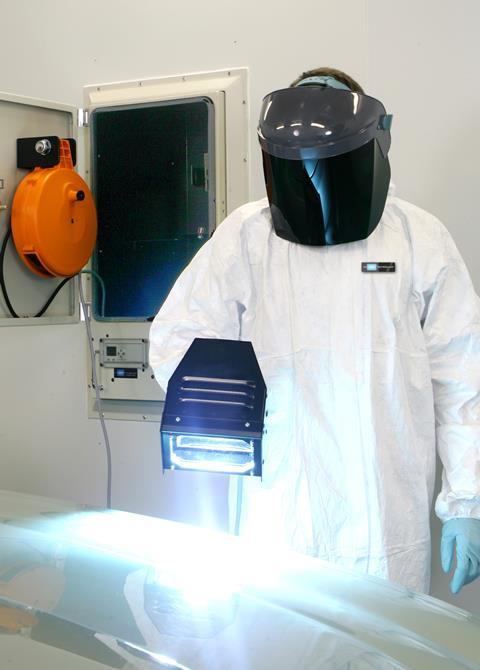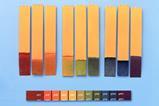Learn about the science behind the bug-busting powers of UV light

At a press conference in late April, US president Donald Trump floated the idea of exposing Covid-19 patients to ultraviolet (UV) light. He suggested doing so could be a ‘powerful’ way to ‘kill’ coronavirus particles inside of them. This proposed treatment caused uproar in the scientific community. ‘Our very clear message is: please don’t do that,’ states Ron Hofmann, president of the International Ultraviolet Association, and an expert in UV disinfection at the University of Toronto in Canada.
In your class
The use of UV radiation in fighting coronaviruses is extremely topical at the moment thanks to remarks by high-profile politicians. Use this context to engage your students in some cross-curricular scientific reading.
Harnessing a natural killer
UV light sits on the electromagnetic spectrum between visible light and X-rays. This section of the spectrum is divided into three: UVA and UVB, both of which we are constantly exposed to when outside, and UVC, which we are not. All three types are emitted by the sun. UVC rays, however, are absorbed by ozone in the Earth’s upper atmosphere before they can hit our planet’s surface. This is fortuitous because, although UVA and UVB rays also cause damage to the DNA in both skin cells and the retinas of eyes, UVC rays are the most harmful of the trio (there is a potential exception to this rule, far-UVC, which we discuss later).
It is the high potential to do harm that rules out UV as a treatment for patients with Covid-19. But UV, specifically UVC, does have a helpful role to play during the current pandemic: as a disinfectant tool.
This is because UVC radiation doesn’t just damage human DNA; it also harms genetic material in all other living things on Earth. This includes viruses, bacteria and fungi. ‘The DNA and the RNA of microorganisms absorb the ultraviolet light and break down,’ explains Ron. ‘This stops them from being able to reproduce.’
The bug-busting powers of UVC have been known about for over a century and UVC lamps are widely utilised today in applications ranging from disinfecting surfaces in microbiology laboratories, to treating drinking water, to zapping processed foods on production lines before packaging. Over the past decade, UVC lamps have also seen increasing use for disinfecting medical facilities such as hospitals and care homes.
Download this
Comprehension exercise, for age ranges 11–14, 14–16
Reading for purpose is an important skill for students and comprehension activities are familiar activities for younger pupils. As the type of activity is familiar to students from their primary education, this means the level of text provides the challenge. Students read the text carefully to find the answers to the questions, learning about the use of UV radiation in disinfection.
You can download the article text alongside the questions and answers either as a presentation to project for your class (as MS Powerpoint or pdf), or as a question worksheet (as MS Word or pdf) with separate answer sheet (as MS Word or pdf).
A comprehension exercise for age range 11–14, 14–16 to engage students with some highly topical cross-curricular science and boost their literacy skills, from the Education in Chemistry website:
Types of UV devices
The coronavirus particles responsible for Covid-19 predominantly spread from person to person via droplets in the air – similar to those responsible for the common cold and flu. These are either breathed in by others or land on surfaces before being picked up and accidentally transported to the eyes, mouth or nose of a new host, where they can enter the body.
UVC is useful for tackling both airborne coronavirus particles and those that have settled on surfaces. ‘UV robots are the most prevalent devices in the UK, a number of hospitals now have them,’ explains Cath Noakes, an expert in the use of UV disinfection in buildings at the University of Leeds. These robots, or trolleys, are wheeled into recently vacated treatment rooms where they then scan the room for approximately 10 minutes, disinfecting both the air and all visible surfaces.
For safety reasons, rooms must be empty during scanning. ‘The trolley has built-in safety features so that it cuts out if anyone enters the room while it’s on,’ explains Dan Arnold, sales and marketing manager at UV Light Technology, a specialist UV device manufacturer in Birmingham, UK.

Another device currently rapidly gaining in popularity during the pandemic, according to Dan, is a handheld UVC disinfection lamp. This is manually scanned closely over surfaces to decontaminate them. Some customers prefer them because they are cheaper and also slightly easier to get into nooks and crannies, Dan explains. ‘We provide UV blocking shields with these devices,’ he adds. Operators should also wear other personal protective equipment (PPE). ‘The rest of the body including hair and hands need to be completely covered.’
Prior to the current pandemic, most of Dan’s customers for the handheld lamp worked in microbiology laboratories. ‘Now we are getting enquires from every industry you can imagine,’ he says. ‘This includes public transport companies wanting to use them to disinfect vehicles between use, hotels wanting to use them to disinfect rooms, and even people wanting to disinfect go-kart helmets.’
Dan describes his handheld devices as professional solutions, and both he and Ron caution the general public against purchasing UVC lamps online. ‘These often lack proper safeguards to protect the user,’ Ron says.
Even when used professionally it should be noted that UVC has its limitations. One of these is line of sight – microorganisms are only inactivated if the light directly hits them. Virus particles hidden in the depths of 3D structures will get missed, explains Ron. ‘It’s a very different scenario from disinfecting the top of a stainless steel tabletop in a room.’ This is why the proposal to use UVC to disinfect medical face masks, and other medical PPE in short supply, is causing concern. Ron says it should only be considered in conjunction with another technique, such as a hydrogen peroxide treatment.
Looking forward
While current UV technologies have been spreading inside our medical facilities in recent years, researchers have been working to develop next generation devices. These include UV LEDs (light emitting diodes). ‘People are exploring LED technologies across all the different wavelengths of UV,’ explains Cath. These devices can be smaller and more flexible than those with low-pressure mercury lamps and fluorescent tubes. They can also be designed to produce very specific wavelengths that target a particular microorganism. Emitting only the strictly necessary UVC rays has obvious safety advantages.
A second technology that utilises only a narrow band of the UVC spectrum is also being explored: far-UVC. Researchers working on this area believe that far-UVC rays can inactivate microorganisms without being able to penetrate either human skin or the eye. They have proposed that continuous, low dosages of far-UVC light could be used in indoor public locations to reduce the spread of airborne microbial diseases. Ron describes their work as ‘theoretically promising’, but notes that ‘much work remains to be done to be able to safely and confidently move this technology out of the lab and into actual practice’. Rules on acceptable amounts of UV exposure would also have to be tweaked before this can be idea can be implemented. ‘Current EU exposure limits would be exceeded pretty quickly,’ says Dan.
In light of the current coronavirus pandemic, regardless of whether or not these new types of lamps ever hit the mainstream, the use of UV technology for disinfection in healthcare facilities looks set to have a very bright future indeed.
More recommended resources
More on the science of light, as well as on fighting viruses:
- The science of hand washing and hand gel
- Take a closer look at coronavirus at the molecular level
- Give older students an overview of medicinal chemistry with this series of activities developed in partnership with Reckitt Benckiser
- The chemistry of light is fascinating – as shown by this series of videos featuring Peter Wothers
- Have students examine the chemical structures of some of the UV-absorbing chemicals in sunscreen
- An experiment to measure the speed of light with just a microwave and some bread and butter
- Learners can read about Tyler’s work as an apprentice technician doing experiments linked to covid research
- The science of hand washing and hand gel:
- Take a closer look at coronavirus at the molecular level:
- Give older students an overview of medicinal chemistry with this series of activities developed in partnership with Reckitt Benckiser:
- The chemistry of light is fascinating – as shown by this series of videos featuring Peter Wothers:
- Have students examine the chemical structures of some of the UV-absorbing chemicals in sunscreen:
- An experiment to measure the speed of light with just a microwave and some bread and butter:



















No comments yet